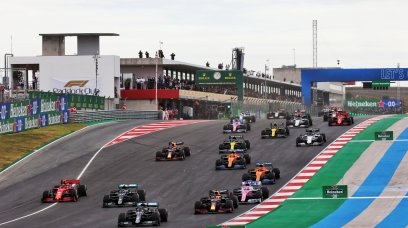The FIA is undertaking a comprehensive review of the opening laps incidents during the Japanese Grand Prix at Suzuka, RacingNews365 has learned. The review stems from Race Director Eduardo Freitas’s decision to deploy a tractor to clear Carlos Sainz’s stricken Ferrari under a red flag before realising Pierre Gasly was approaching the scene. The Frenchman had started from the pit lane in his AlphaTauri before pitting after incurring damage caused by debris from Sainz’s crash into the barriers. After the incident, which shared some eery similarities with the 2014 accident which ultimately claimed the life of Jules Bianchi at the same venue, the FIA issued the following statement: “In relation to the recovery of the incident on Lap 3, the Safety Car had been deployed and the race neutralised. Car 10 [Gasly], which had collected damage and pitted behind the Safety Car, was driving at high speed to catch up to the field. “As conditions were deteriorating, the Red Flag was shown before Car 10 passed the location of the incident where it had been damaged the previous lap.” Gasly was later handed a 20-second penalty for speeding at over 200km/h on multiple occasions under red flag conditions. However, in mitigation the stewards found, “Although the speed could not by any measure be regarded as ‘slow’ as required in the regulations, it was slower than the maximum speed that could be achieved under these conditions. We also take into account the shock the driver experienced on seeing a truck on the racing line in the corner of the incident.”
RacingNews365 understands that the governing body’s Deputy President for Sport Robert Reid, who was present in Suzuka, has taken personal charge of the review, having ordered that all aspects be analysed, including various factors leading to the incident and the subsequent procedures followed, whether by Race Control in Suzuka, the (remote) VAR-like Remote Operations Centre (ROC) in Geneva or trackside. Reid, a former WRC-winning co-driver and staunch safety protagonist after experiencing tragedies on the rally circuit and in wider motor sport, is determined to apply any lessons learned from the review via robust measures and processes across the entire sport, not only F1. The Scot is said to have told staff he will leave no stone unturned. The review is also likely to consider whether a concept of rotating race directors is viable or whether a return to a permanent race director with a full-time deputy is preferable. The current system was introduced after last year’s Abu Dhabi controversy. Then-Race Director Michael Masi was found to have been overtasked, leading incoming FIA President Mohammed Ben Sulayem to introduce rotation as a stop-gap measure. The rotating system has come in for criticism from drivers and team bosses, with George Russell, a Grand Prix Drivers Association Director, saying in Silverstone, “Over the course of the year, a number of drivers commented on this [inconsistency of decisions]. I think when you've got one Race Director, things can generally be more consistent.” Immediately after the incident ROC staff, under the lead of Safety Director Tim Malyon, began collecting and analysing all available data from the incident, which together with testimonies will form the basis of the review. The initial results are expected to be released early next week
Rencken Reckons...
Eduardo Freitas’s instruction for the tractor to enter the track - usually such a decision is taken in conjunction with the (local) Clerk of Course who is in contact with post chiefs in their own language - is utterly inexplicable and was clearly erroneous. However, I wonder what role his deputy for the event Niels Wittich played. If the German, the ‘deputy rotater’ on Sunday, did not point out aspects that Freitas had overlooked in the confusion, then he, too, is culpable to larger or lesser degree given a deputy’s task is to provide advice when the Race Director is overloaded, as Freitas clearly was. That suggests that the rotating concept does not work and should be replaced by a line structure of permanent race director and a deputy, who steps in as and when required. Equally, questions should be asked about real time input from the ROC – what role did staff back in Geneva play. True, it is a new, evolving concept, so maybe its remit should be widened. Finally, there are no doubts that the root cause of Sunday’s incidents was Suzuka’s weather pattern and pressure brought to race in such conditions for commercial reasons, whether from the local promoter, rights holder F1 or TV broadcasters. Where previously the commercial rights holder and fans rubbed their hands in glee at thoughts of racing in rain – then-F1 tsar Bernie Ecclestone (half) jestingly suggested sprinklers at circuits to ‘spice’ the show - for safety reasons, mainly visibility and not tyre performance, races are delayed or started under Safety Cars immediately rain drops fall. Rightly (for safety) or wrongly (in the eyes of traditionalists), that is evident. We saw that in Spa last year, in Monaco this year, in Singapore a fortnight ago and Suzuka last week - and these are but a handful of examples. Thus, one wonders about the wisdom of scheduling grands prix during rainy seasons – as was popular during Ecclestone’s era. Scheduling Suzuka for typhoon season is begging for stoppages; ditto Austin during times of hurricane prevalence. As F1 chases calendar expansion so the chances of rain-hit events increases exponentially, particularly when promoters are permitted to ‘buy’ or dictate slots. True, F1’s needs to group races geographically for logistics and ‘green’ reasons and hence two consecutive races during Asia’s rainy season, but the price of such calendars is increasing stoppages or red flags to the detriment of the overall show. F1’s ‘new era’ cars rely on ground-effects (suction) for downforce, expelling underbody air to function. On-track water gets sprayed out at high speed as part of the process, causing mist and major visibility issues. When I mentioned potential wet weather visibility issues with the 2022 cars to an F1 figure in the wake of Spa last year it was laughed at, but it is now increasingly accepted as a cause. As with ‘bouncing’, it is an unintended consequence of the 2022 car concept. The fact is that times have changed but the calendar has not – the broad structure is as it was a decade ago, with additional races simply squeezed into any convenient gaps. Consider: the chances of rainfall in Sao Paulo in November are five times August, yet F1 sticks to its traditional slot. If next month’s race is disrupted, remember that. Ditto the greater Nagoya area in which Suzuka finds itself: Chances of rain in August/September are considerably lower than in October, but that doesn’t suit F1’s calendar structure, logistics or the promoter, who insists on an October slot as part of the deal - the net effect being regular chaos or disruption for this race, which was fine back then, but safety now dominates. All in, fans and TV viewers are increasingly paying the price, either via truncated events or delayed schedules which disrupt their pleasure. Netflix has attracted millions of new eyeballs to the sport, and two-hour waits for action are unlikely to retain them. Enthuse them or lose them – and if safety is non-negotiable – as I should be - then the contributory factors must be…
Most read






